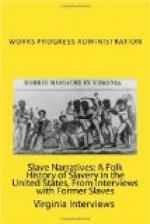“De Chil’s place was at Livingston, Alabama, on Alamucha Creek. Dat’s where I was born, but I jus’ did git borned good when Miss Lizzie—she was Marse Chil’s girl—married Marse John C. Higgins an’ moved to Mer-ree-dian. Me an’ my mammy an’ my two sisters, Liza an’ Tempe, was give to Miss Lizzie.
“I aint no country Nigger; I was raised in town. My mammy cooked an’ washed an’ ironed an’ done ever’thing for Miss Lizzie. She live right where Miss Annie—she was Miss Lizzie’s daughter—live now. But den de house face Eighth Street ‘stead o’ Seventh Street, lak it do now. Day warnt any other houses in dat block. ’Fore de Surrender, dey turnt de house to face Seventh Street ‘cause de town was growin’ an’ a heap o’ folks was buildin’ houses. I tell you somp’in’ ’bout Seventh Street in a minute. Couldn’ nobody dat lived in Mer-ree-dian right after de Surrender ever forgit Seventh Street an’ where it head to.
“My pappy didn’ go wid us to Mer-ree-dian. He b’longed to one set o’ white people, you see, an’ my mammy b’longed to another. He’d come to see us till de War started, den his folks jus’ kinda went to Texas. I don’ know why zackly ‘cep’ maybe it warnt so healthy for ’em ‘roun’ Livingston. Dey didn’ go to de War or nothin’. I ‘spec’ nice white folks talked ’bout ’em an’ wouldn’ have nothin’ to do wid ’em. So dey took an’ went to Texas an’ took my pappy wid ’em. But after de War he come back to us, walked mos’ all de way frum Texas. He rented some lan’ frum Mr. Ragsdale. My pappy built us a shack on dat lan’. It’s tore down now, but it was built good. Us all he’ped. I pulled a cross-cut saw an’ toted de boards up on de roof on a ladder. De chimley was built out o’ mud an’ rocks. Den us moved in an’ started growin’ us somp’in t’eat. Us didn’ have no horse an’ plow; Yankees done carried off all de horses an’ mules an’ burnt up ever’dthing lak plows. Us dug up de groun’ wide a grubbin’ hoe an’ raised pun-kins an’ plenty o’ chickens an’ ever’thing.
“Us lived nice. My people was smart. My white people was good white people. Dey warnt brutish; never whupped us or nothin’ lak dat. I don’ know nothin’ ’bout no meanness.
“Mr. Higgins he died pretty soon an’ Miss Lizzie went to teachin’ school. Her chillun—Miss Annie an’ dem—would try to teach us. Den us carried Blue Back Spellers to Sund’y school an’ a old Baptist cullud preacher would teach us out o’ it. He say, ’de same words is in dis book what’s in de Bible. You chillun learn ’em de way dey is fixed for you to learn ’em in dis here Blue Back Speller, den de firs’ thing you know you can read de Bible.’ Use went to de white folk’s church endurin’ o’ de War an’ right after. Any o’ de white folks can tell you ’bout Mr. Preacher Hamlin. He was a preacher an’ a school teacher mixed. He had de firs’ boardin’ school for young white ladies. It’s standin’ right dare on Eighth [HW: No 7] Street right now. I ‘members de firs’ one to gragurate[FN: graduate] frum it. Well, Mr. Hamlin ’nitiated my pappy right dare in de white folks’s church, de Firs’ Baptis’ Church; it burnt up long time ago. My pappy was Isam Allbrook. He was de firs’ cullud deacon ordained in Mer-ree-dian.




